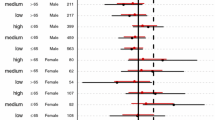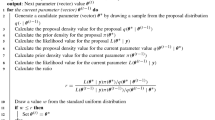Abstract
Specific bivariate classes of distributions with given marginals can be used for contribution of the linking distribution between conditional and unconditional effectiveness using copulas. In this paper, a Bayesian model is proposed for meta-analysis of treatment effectiveness data which are generally discrete Binomial and sparse. A bivariate class of priors is imposed to accommodate a wide range of heterogeneity between the multicenter clinical trials involved in the study. Applications to real data are provided.
Similar content being viewed by others
References
Sweeting MJ, Sutton JA, Lambert PC (2004) What to add to nothing? Use and avoidance of continuity corrections in meta-analysis of sparse data. Stat Med 23(9):1351–1375
Lambert PC, Sutton AJ, Burton PR, Abrams KR, Jones DR (2005) How vague is vague? A simulation study of the impact of the use of vague prior distributions in mcmc using winbugs. Stat Med 24(15):2401–2428
Joe H (1997) Multivariate models and multivariate dependence concepts. CRC Press, Boca Raton
Casella G, Moreno E (2005) Intrinsic meta-analysis of contingency tables. Stat Med 24(4):583–604
Chu H, Nie L, Chen Y, Huang Y, Sun W (2012) Bivariate random effects models for meta-analysis of comparative studies with binary outcomes: methods for the absolute risk difference and relative risk. Stat Methods Med Res 21(6):621–633
Chen Y, Chu H, Luo S, Nie L, Chen S (2015) Bayesian analysis on meta-analysis of case-control studies accounting for within-study correlation. Stat Methods Med Res 24(6):836–855
Fienberg S (1992) Comment to hierarchical models for combining information and for meta-analyses. Bayesian Stat 4(70):321–344
Fisher LD, Van Belle G (1993) Biostatistics. A Methodology for the Health Sciences. Wiley, New York
Collins R, Peto R, Flather M, Parish S, Sleight P, Conway M, Pipilis A, Baigent C, Barnett D, Boissel J et al (1995). Isis-4-a randomised factorial assessing early oral captopril, oral mononitrate, and intravenous magnesium sulphate in 58.050 patient with suspected acute myocardial-infarction. Lancet 345(8951):669–685
Egger M, Davey Smith G (1995) Misleading meta-analysis. lessons from “an effective, safe, simple” intervention that wasn’t. BMJ 310:752–754
Egger M, Smith GD, Schneider M, Minder C (1997) Bias in meta-analysis detected by a simple, graphical test. BMJ 315(7109):629–634
Fisher N (1997) Copulas. In: Kotz S, Read CB, Banks DL (eds) Encyclopedia of statistical sciences, vol 1, pp 159–163
Nelsen R, Quesada-Molina J, Rodríguez-Lallena J (1997) Bivariate copulas with cubic sections. J Nonparametric Stat 7(3):205–220
Quesada-Molina J, Rodríguez-Lallena J (1995) Bivariate Copulas with quadratic sections. J Nonparametric Stat 5(4):323–337
Nelsen RB (2007) An introduction to copulas. Springer, New York
Sklar M (1959) Fonctions de repartition an dimensions et leurs marges. Publ Inst Stat Univ Paris 8:229–231
Moreno E, Vázquez-Polo F, Negrín M (2014) Objective Bayesian meta-analysis for sparse discrete data. Stat Med 33(21):3676–3692
Lapuyade-Lahorgue J, Xue JH, Ruan S (2017) Segmenting multi-source images using hidden Markov fields with Copula-based multivariate statistical distributions. IEEE Trans Image Process 26(7):3187–3195
Zhang A, Fang J, Calhoun VD, Wang Yp (2018) High dimensional latent gaussian copula model for mixed data in imaging genetics. In: 2018 IEEE 15th International Symposium on Biomedical Imaging
Bahrami M, Hossein-Zadeh GA (2015) Assortativity changes in alzheimer’s diesease: A resting-state fmri study. In: 2015 23rd Iranian Conference on Electrical Engineering. IEEE
Eban E, Rothschild G, Mizrahi A, Nelken I, Elidan G (2013) Dynamic copula networks for modeling real-valued time series. In: Artificial Intelligence and Statistics, PMLR
Onken A, Grünewälder S, Munk MH, Obermayer K (2009) Analyzing short-term noise dependencies of spike-counts in macaque prefrontal cortex using copulas and the flashlight transformation. PLoS Comput Biol 5(11):e1000577
Bao L, Zhu Z, Ye J (2009) Modeling oncology gene pathways network with multiple genotypes and phenotypes via a copula method. In: 2009 IEEE Symposium on Computational Intelligence in Bioinformatics and Computational Biology. IEEE
Kwitt R, Uhl A, Häfner M, Gangl A, Wrba F, Vécsei A (2010) Predicting the histology of colorectal lesions in a probabilistic framework. In: 2010 IEEE Computer Society Conference on Computer Vision and Pattern Recognition-Workshops. IEEE
Kon MA, Nikolaev N (2011) Empirical normalization for quadratic discriminant analysis and classifying cancer subtypes. In: 2011 10th International Conference on Machine Learning and Applications and Workshops. IEEE
Iyengar SG, Varshney PK, Damarla T, Bhanu B, Govindaraju V (2011) Biometric authentication: a copula-based approach. Cambridge University Press, Cambridge
Susyanto N, Veldhuis R, Spreeuwers L, Klaassen C (2019) Semiparametric likelihood-ratio-based biometric score-level fusion via parametric copula. IET Biometrics 8(4):277–283
Tuyl F, Gerlach R, Mengersen K (2008) A comparison of Bayes-Laplace, Jeffreys, and other priors: the case of zero events. Am Stat 62(1):40–44
Bairamov I, Kotz S (2002) Dependence structure and symmetry of Huang-Kotz FGM distributions and their extensions. Metrika 56(1):55–72
Lin G, Huang J (2011) Maximum correlation for the generalized Sarmanov bivariate distributions. J Stat Plan Inference 141(8):2738–2749
Bairamov I, Kotz S, Bekci M (2001) New generalized Farlie-Gumbel-Morgenstern distributions and concomitants of order statistics. J Appl Stat 28(5):521–536
Bairamov I, Altinsoy B, Kerns GJ (2011) On generalized Sarmanov bivariate distributions. TWMS J Appl Eng Math 1(1):86
Acknowledgements
The first author is grateful to Department of Science and Technology, Govt. of India for providing financial assistance for carrying out this work. All the authors also acknowledge the support provided by DST under PURSE grants.
Author information
Authors and Affiliations
Corresponding author
Additional information
Publisher's Note
Springer Nature remains neutral with regard to jurisdictional claims in published maps and institutional affiliations.
Rights and permissions
About this article
Cite this article
Jain, S., Sharma, S.K. & Jain, K. Using Copulas for Bayesian Meta-analysis. Stat Biosci 14, 23–41 (2022). https://doi.org/10.1007/s12561-021-09312-8
Received:
Revised:
Accepted:
Published:
Issue Date:
DOI: https://doi.org/10.1007/s12561-021-09312-8




